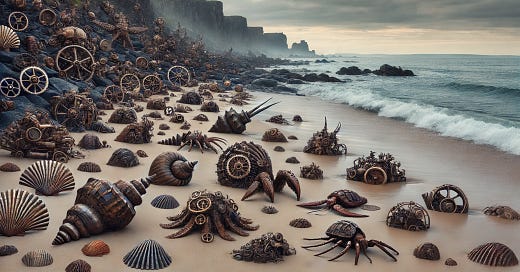This week has been a little quiet around campus. Our Year 12 students graduated at the end of last week and they have been in and out, catching up with teachers and studying for their upcoming exams. The customary signs and cordoned-off areas returned as our Year 12s sat their English exams across Tuesday, Wednesday and Thursday. English is a compulsory subject in Victoria so all students study either a combined course, English language or English literature.
Those of you who have been following my teacher training survey will be pleased to know it ticked over 1000 responses on Tuesday and so there is a job ahead to begin to analyse the data.
It seems a long time ago now that I was holidaying in Queensland, taking in the sea air and visiting the amphitheatre in Noosa’s botanical gardens. And so, perhaps fittingly, this week was a moment to turn to the future, with the school board discussing its strategic plan for Clarendon. Exciting times lie ahead.
This week’s Curios include some snippets, a petition, some working class male university students and much more.
Gobbledygook of the week
This week, Mark Selkrig, an Associate Professor of Education at the University of Melbourne treated us to some truly extraordinary verbiage courtesy of the always-good-value blog of the Australian Association for Education Research (AARE).
It is so jargon-laden, it is hard to know whether Selkrig is making a larger point, or simply dressing up his argument for more art in schools in obscure clothes. I followed it as far as the idea that art is both a creative endeavor in its own right and therefore, “awakens the full spectrum of human ways of knowing, exploration mindsets and personal growth,” and also a good way of learning other stuff. I also noticed the typical educational progressivist argument against, “prescribed knowledge, regurgitated on exams or for tests.” This is a classic false choice. There is no tension between knowing lots of things and being creative. The two are mutually reinforcing.
But is there any more to it than that? It is hard to tell. What, for instance, are we to make of Selkrig’s concerns about teachers working together in teams:
“…with the current trend for teachers to work with colleagues as a member of a professional learning community (PLC), are they able to work cooperatively to design innovative, arts-integrated lessons to awaken students’ imaginative visioning abilities, critical consciousness, changemaking impulses and self-actualizing identities as bold co-creators of more beautiful realities.”
It’s hard to read that without smiling. The prose is both purple and pompous.
I guess that if educational progressivists want to make themselves look silly then that at least saves me a job. Perhaps I should have left it there.
However, I was so taken with the wordy and quixotic Professor Selkrig that I decided to look up his publications on Google Scholar—and oh, my! I found a blog he co-wrote on the British Educational Research Association’s (BERA) blog that is, if you can believe it, even sillier:
“We asked participants via a series of surveys to respond to four stem sentences related to the troublesome, delightful, ambiguous and hopeful dimensions of working in teacher education by providing an associated image such as a photograph of a drawing, painting or sculpture, or an image they had sourced from the web. From these responses, we created four posters of participants’ images and text.”
If you click on the link—and you should—you can download one of the posters. It is very funny. On part of the poster, under an image of French Firemen (!), is the text:
“Clearly happy, French firemen gather to celebrate a colleague's marriage. There's something to look forward to; optimism about what lies ahead. So too with teacher education in Australia: after years of working in isolation, the three TPA consortia that formed after TEMAG are now finding their collective voice. They are starting to talk back.”
However, what is not funny is that this is the kind of research and these are the types of ideas that we are exposing trainee teachers to instead of empirical evidence from educational psychology and instructional science.
Media appearance of the week
I was quoted by Lucy Carroll in The Sydney Morning Herald. Carroll had unearthed worrying data on the decline in students taking higher level mathematics in New South Wales. The typical answers to this problem are to somehow make maths more relevant (wrong), to make it compulsory to age 18 (wrong), and to recruit more specialist maths teachers (good idea but not the biggest lever). I made the point that if we want more students to opt into maths, we need to make them better at the subject by teaching it really well, starting in primary school:
“We should also avoid selling maths apologetically, pleading its usefulness in everyday life. We don’t do that with other subjects. It’s not motivating, that comes from progress and success.”
I have had some positive feedback.
Blogging stalwart of the week
Andrew Old is the original education blogger. When I started writing about education in 2012, he was already six years into his blogging career. I know this because he has just released a Substack post to mark his eighteenth anniversary.
I owe Andrew. In the early days, he shared a post of mine about textbooks to his network and that kicked things off for me. He is also a relentlessly rational voice in the soup of emotion, fashion and bias that bedevils the job of teaching in schools—a job he continues to do. He is worth following.
Needs of the week
Sometimes, bureaucrats and policymakers decide that education systems should do impossible things. However, this does not make these systems any more capable of doing those impossible things—a logical step often neglected.
Keep reading with a 7-day free trial
Subscribe to Filling The Pail to keep reading this post and get 7 days of free access to the full post archives.





